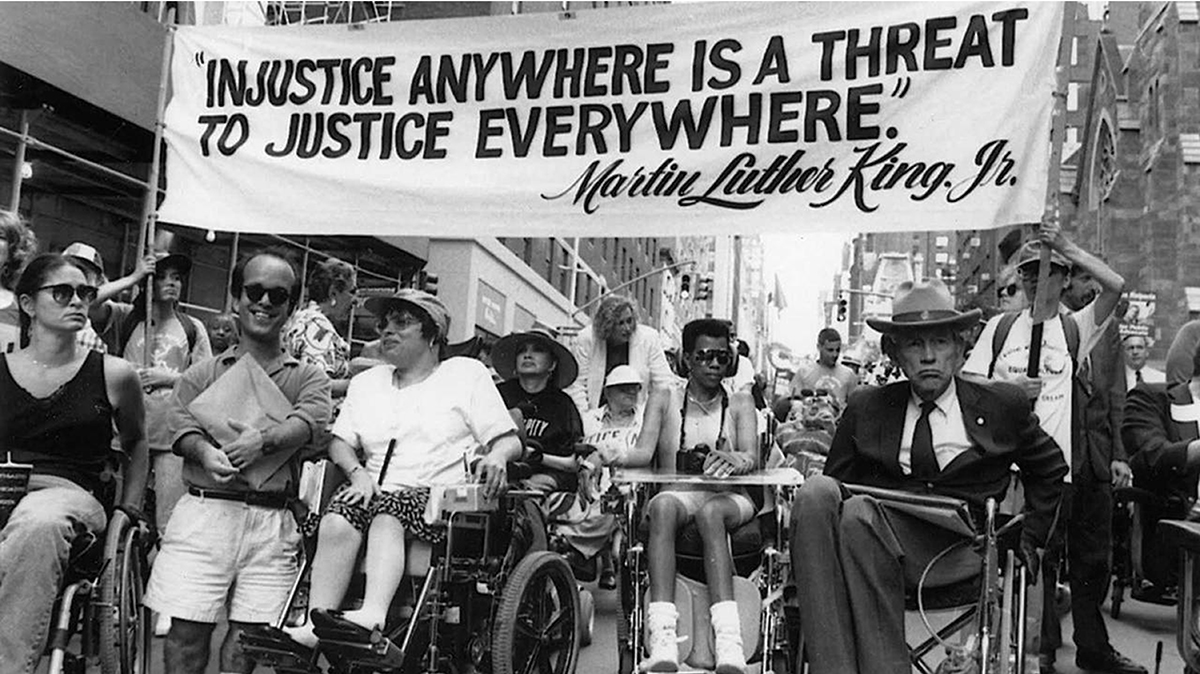You are here:
The Disability Independence Day March

Date: Jul 26, 1993
Caption: Participants in one of the first Disability Independence Day marches in New York City gathered under a banner that reads “‘Injustice Anywhere is a Threat to Justice Everywhere,’—Martin Luther King, Jr.”

After Camp Jened closed in 1977, many former campers stayed connected to one another. The sense of community and possibility they built at camp became an inspiration and source of strength for the developing disability rights movement.1
Through the Great Depression, World War II, and into the Cold War, Disabled people and their allies laid important groundwork that later disability activists built on. Activists began to identify disability as a social category linked to and used to justify inequality. They sought connection across people with different kinds of disabilities, although racism, classism, sexism, and other divisions hindered cross-disability organizing. Civil rights wins led by African Americans and other people of color provided the movement a language of rights. Disability rights activists turned to legal victories like Brown v. Board of Education (ending racial segregation in schools) as resources in making their own claims against segregation and for access for Disabled people.2
In the 1960s and 1970s, earlier strands of disability rights activism became a more unified movement. Activism by Disabled people and their allies secured legislation against discrimination and for funding and legal requirements for accessibility. Activists criticized oppressive institutions (as in the struggle against New York City’s Willowbrook) and expanded educational access from early childhood through university.3 Camp Jened alumni including Judy Heumann and others were visible leaders of this movement.
In one key victory, the Americans with Disabilities Act (ADA) became law on July 26, 1990. Disabled people and those in solidarity with them launched the first-ever Disability Pride Parade in New York City that year. Organizers including Nadina LaSpina and Danny Roberts helped establish the tradition of marking the passage of the ADA with a parade in New York City.
This is a photograph from the second parade, in the summer of 1993. That year, Tari Sue Hartman Squire and photographers Justin and Yoshiko Dart traveled to the city to participate. Dart appears in the photo, along with Paul Steven Miller, who was the commissioner for the Equal Opportunity Employment Commission (EEOC) and a professor. Judy Heumann appears in the white shirt and baseball cap at the center of the photograph.
Many of Camp Jened’s alumni, like many of the leaders of the disability rights movement in the 1970s and 1980s, were white people with physical disabilities. While they recognized the importance of the African American civil rights movement as an influence on their work, the movement did not fully include all Disabled people or respond to the ways that people’s experiences of disability varied depending on their race, class, gender, and sexuality.4
The more recent disability justice movement was founded in part in response to the limitations of the historic disability rights movement. Disability justice organizations like Sins Invalid are led by and define their goals by focusing on the needs and visions of Disabled people of color.5
-
Crip Camp, directed by James Lebrecht and Nicole Newnham (2020: James Lebrecht, Nicole Newnham, and Sara Bolder), netflix.com. ↩︎
-
Kim E. Nielsen, A Disability History of the United States (Boston: Beacon Press, 2013). ↩︎
-
Nielsen, A Disability History. ↩︎
-
Emily Ladau, Demystifying Disability: What to Know, What to Say, and How to Be an Ally (New York: Clarkson Potter/Ten Speed, 2021) and Jim LeBrecht, interviewed by Jessica Murray and Jasmine Leiser, April 28, 2023, via Zoom. ↩︎
-
Patty Bern and Sins Invalid, Skin, Tooth, and Bone: The Basis of Movement is Our People: A Disability Justice Primer, 2nd ed. (Berkeley: Sins Invalid, 2019). ↩︎
Categories: Manhattan, community activism
Tags: racist segregation, Disabled people, physical disabilities, self-advocacy, protest, photography, imagery, and visual representation, joy, transportation, employment
Item Details
Date: Jul 26, 1993
Creator: Tari Hartman Squire
Source: Collection of Tari Hartman Squire
Copyright: Under copyright. Used with permission.
How to cite: “The Disability Independence Day March”," in New York City Civil Rights History Project, Accessed: [Month Day, Year], https://nyccivilrightshistory.org/gallery/disability-independence-day-march.
Questions to Consider
- Why do you think the activists in this Disability Rights Parade chose to gather under a banner with this quote from Dr. Martin Luther King, Jr.? What do you think the quote meant to them? What do you think they wanted to communicate to others by choosing this quote?
- How does the activism seen in this photograph relate to the Dr. Martin Luther King, Jr. quote?
- How do you see joy in this photograph? How do you see struggle?
- What connections do you see between this photograph and what you have learned about Camp Jened?
References
How to Print this Page
- Press Ctrl + P or Cmd + P to open the print dialogue window.
- Under settings, choose "display headers and footers" if you want to print page numbers and the web address.
- Embedded PDF files will not print as part of the page. For best printing results, download the PDF and print from Adobe Reader or Preview.
